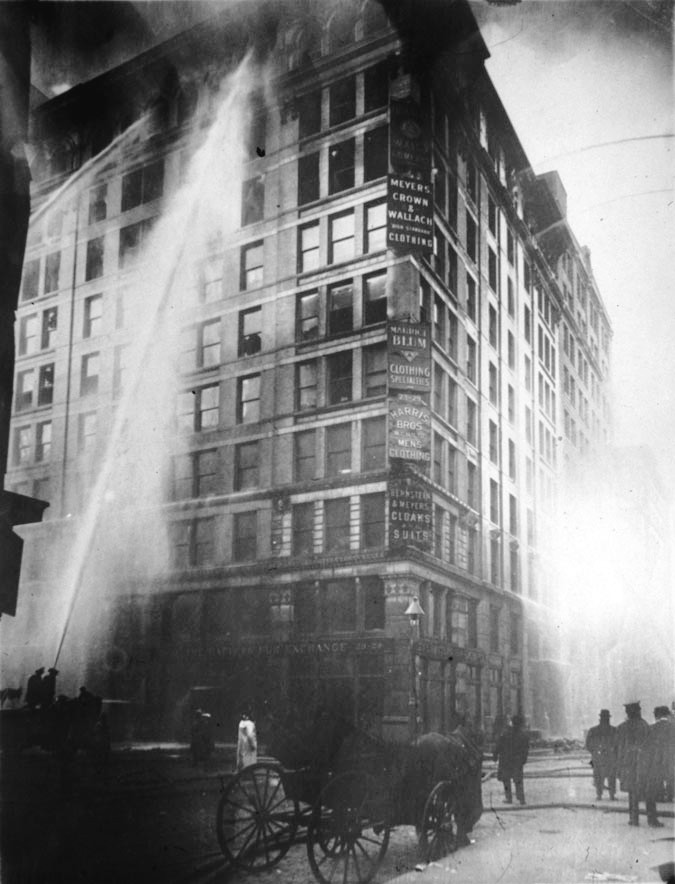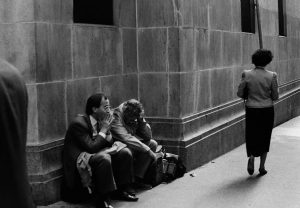It was March 25, 1911, in New York City. It was a Saturday afternoon just like any other at the Triangle Shirtwaist factory, where young immigrant women sat in front of sewing machines, day in and day out, sewing. But on that day a fire broke out, causing the deaths of 146 garment workers. Among those who died in the flames and smoke were 123 women and 23 men.1 Many even jumped or fell to their deaths out the windows, making this event a man-made disaster and one of the deadliest industrial disasters of all time.

The factory was located in the Asch Building at Washington Place in Greenwich Village, one of the wealthiest neighborhoods in the city. The factory occupied the eighth, ninth, and tenth floors of the ten-story building. Max Blanck and Issac Harris were the owners of the factory, and their company was known as the largest firm in the business at the time. They styled women’s blouses known as “Shirtwaists,” which were paired with tailored skirts. This attire had become the standard in fashion for women in the early twentieth century. They were also known to resemble men’s shirts. When it came to their workers, they had hired operators who then contracted out for factory workers. The company itself only dealt with the contractors, and there was no fixed rate of pay for the workers.2 At the time, the factory employed about five-hundred employees, mostly young immigrant women who were of Italian or Jewish descent. These women worked up to eleven-hour shifts on weekdays, and twelve-hour shifts on Saturdays, and they earned between $7-$12 dollars for a 52-hour week. Many of these women were the breadwinners of their household, and their income was sometimes not sufficient to cover their needs.
Towards the end of the workday on that Saturday evening in 1911, a fire broke out around 4:00 pm. The fire started in a scrap bin under one of the cutter’s tables on the eighth floor from what is believed to have come from a cigarette. A manager tried to put the fire out with a hose but the hoses valve was rusted shut, and rotten away. The fire spread quickly and the workers panicked. There was one fire escape that quickly collapsed, and four elevators, which out of the four only one was working. The elevator held twelve people at a time, and it managed to make four rescue trips before it broke down.3 With no other alternatives available, people began throwing themselves out the windows, and some were even crushed to death trying to get out. Workers tried to take the stairs, but the exit doors only opened inward and were kept locked by factory management to prevent theft by the workers, as the managers would check their workers belongings every day before they left for the day.

Celia Saltz Pollack, a survivor of the 1911 Triangle Shirtwaist Fire said,
I remember on that day there was a lot of singing and happiness in the shop because it was the end of the week and we got paid. We were soon all going to go home. When the fire started I was sitting at my machine. I looked up and saw the fire near the cutting tables but I did not think it was so terrible. What was terrible was that the fire spread in a split second.
By the time the firefighters arrived, they came to the realization that their ladders could only extend up to the sixth or seventh floors. With no other option, sixty-two workers jumped and fell to their deaths, while the remaining died from the smoke and flames within the building.4

This fire not only pushed issues of unsafe factories and immigrant exploitation into the public consciousness, but for the first time the fire allowed for attention to be brought to deplorable conditions of New York factories.5 Women obtained well deserved attention onto current work conditions and safety measures in the workplace. Although the Triangle Shirtwaist Factory fire brought a feeling of resentment and heartbreak to many, this event and its victims will always be remembered.
- Ric Burns, “Triangle Shirtwaist Fire,” New York Times (1923-Current File), Nov 24, 1999. ↵
- Jonathan Fink, “Conflagration and Wage: The Triangle Shirtwaist Factory Fire, 1911,” TriQuarterly, no, (2009): 135-136. ↵
- Gale Encyclopedia of U.S. Economic History, s.v. “Triangle Shirtwaist Fire,” by Thomas Carson and Mary Bonk. ↵
- Mia Lynn Mercurio, Régine Randall, “Tributes Beyond Words: Art Educators’ Use of Textiles to Memorialize the Triangle Shirtwaist Factory Fire.” Journal for Learning through the Arts no. 1 (2016): 4-5. ↵
- Albert Marrin, Flesh and blood so cheap: The Triangle fire and its legacy (New York: Alfred A. Knopf, 2011), 23-25. ↵




135 comments
Tara Sellers
This event was unfortunate to have occurred. However, it did help bring light to the factories in New York. If the owners had not locked the door then more people could have gotten out. Also, if someone had made sure that the hose did not rust the fire could have been put out. This article was very well written and interesting.
Troy Leonard
Although this event was extremely sad, you did a great job at writing and constructing this article. also knowing that it took for something so devastating to take place just to finally have something done about the safety in working conditions is mind blowing. if people would have planned ahead and thought that tragedies like this can happen at anytime maybe so many people wouldn’t have lost their lives.
Edith De Loera
As soon as I read “man-made disaster,” I knew I had to read this article. Although the end of this incident was optimistic, it was an unfortunate event, and it is sad that it was done to prove a point. The disaster certainly sparked the need for better working environments to be ensured, but it is devastating that so many people had to lose their lives. This article was extremely well-written and I could tell the research was spectacular.
Megan Barnett
Well written article, the emotion of this event was undoubtedly shown within the style of your writing and the pictures you selected. It is devastating to learn that such a small incident can turn into something causing so much death and destruction. However, this unfortunate occurrence does really make you appreciate the rules and regulations we have today concerning fire safety.
Jesica Rivera
I can briefly remember going over this event in a previous history class. Although it is very tragic many people died due to unsafe working conditions, it did lead to a reform that would prevent this from ever happening again. This is a very well written article. The picture truly add dimension to the article and provide the reader with a view of the fire and the aftermath.
Dayna Valdez
Such a tragic and interesting event. Though I knew about this event, reading the article gave me an even more clear image of it. So many things could have been done to prevent from so many people dying. The elevators that were not working and the exit doors being unlocked. It is hard to imagine people willing to jump out of windows to save their lives, only to get hurt either way.
Sarah Mares
I had no previous knowledge of this topic but was immediately drawn in by the title of the article and knew that I had to read it. I think that it is extremely tragic what happened in the Triangle Shirtwaist Factory. The loss of 123 women and 23 men is not the result of some subtle office damage, but of a heartbreaking accident due to many flaws located in that specific factory accompanied by various safety measures that were not taken. This article was great in telling the events that occurred in New York, but also in its conclusion reminding the readers that the result of this will never be forgotten and opened up a new realm of importance partaking safety in the workplace.
Eduardo Foster
Great article! I have never heard of this story before. What a tragedy happen back in Asch Building at Washington Place in Greenwich Village. It is amazing lesson of life to always put safety first after all. It is sad to heard the dead of 136 people. Great article and good job making the flow of the story. Keep it up with the great work!
Erik Shannon
This is just a tragedy! Left and right of this building showed no health and safety standards what so ever. In today’s society we have come to the point that corporations and business just make this a race to find the cheapest labor and when they do they do not worry about the safety conditions but how much money they are profiting off of it. This article is a great article touching on this disastrous event. It’s a shame what happened.
Clarissa Bustamante
This was such a great article but a very tragic and awful incident it was. It makes a whole more sense as to why there are all these rules and regulations at factories so that nothing like this would have to the opportunity to occur again. Although it was a horrible event it was also a good one so that the law would be forced to enhance the safety precautions of all factories. This article was very descriptive and did very well showing that at anytime any thing can change.